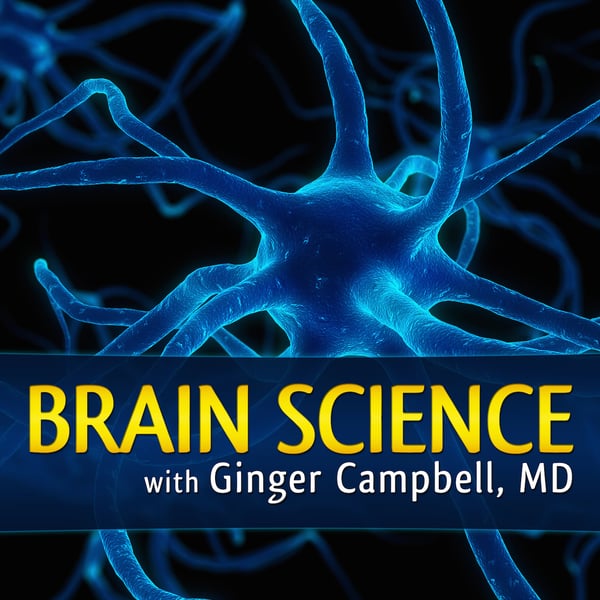BS 166: Stephen Macknik talks about Vision Research
Brain Science with Ginger Campbell, MD: Neuroscience for Everyone
Ginger Campbell, MD
4.8 • 896 Ratings
🗓️ 24 January 2020
⏱️ 69 minutes
🧾️ Download transcript
Summary
Brain Science 166 features the return of neuroscientist Stephen Macknik. We talk about his recent work that is focused on developing a new visual prosthesis based on recent discoveries and techniques like optogenetics.
This episode is more technical than usual but Dr. Macknik makes the material accessible to all listeners.
Links and References:
- http://macknik.neuralcorrelate.com
- YouTube video: https://youtu.be/TiA1W1OnU9c
- Please visit http://brainsciencepodcast.com for additional references and episode transcripts.
Please Visit Our Sponsor:
The Great Courses Plus: http://thegreatcoursesplus.com/ginger
Announcements:
- Brain Science comes out on the 2nd and 4th Friday each month.
- To win an Amazon gift certificate: post a review of Brain Science in iTunes and send me a screenshot.
- Learn how you can support Brain Science at http://brainsciencepodcast.com/donations
- Sign up for the free Brain Science Newsletter to get show notes automatically every month.
- Check out the free Brain Science Mobile app for iOS, Android, and Windows. (It's a great way to get both new episodes and premium content.)
- Send email to [email protected] or post voice feedback at http://speakpipe.com/docartemis.
Connect on Social Media:
- Twitter: @docartemis
- Facebook page: http://www.facebook.com/brainsciencepodcast
Contact Dr. Campbell:
- Email: [email protected]
- Voicemail: http://speakpipe.com/docartemis
Transcript
Click on a timestamp to play from that location
| 0:00.0 | What we're trying to do is we're trying to apply what we know about vision to creating a device that can take information from a camera and stick it into the visual system so that a blind person can see with the camera in a very similar way |
| 0:16.7 | or the same way that they see with their real eyes when they're not blind. Welcome to brain science, a podcast where we explore how recent discoveries in neuroscience |
| 0:32.0 | are unraveling the mystery of how our brain makes us human. |
| 0:35.6 | I'm your host Dr. Ginger Campbell and this is episode 166. You can get complete show notes and episode transcripts on my website at brain science |
| 0:47.6 | podcast.com. You can send me feedback at brain science Podcast at gmail.com, voice feedback via |
| 0:56.2 | speakpipe.com, forward slash Doc Artemis and you can post feedback on the brain science podcast fan page on Facebook. |
| 1:06.0 | Today's guest, Neuroscientist Stephen Macknick has spent his career studying vision and today he will be telling us about a new |
| 1:15.3 | approach to creating a visual prosthesis. The key difference in the approach he |
| 1:20.6 | will describe is that it does not involve using electrodes but rather |
| 1:24.9 | takes advantage of new discoveries as well as techniques such as optogenetics. |
| 1:30.7 | Today's episode is rather technical. |
| 1:35.0 | So I want to give you a little background information before we jump into the interview. |
| 1:40.0 | Early on, Dr. McNick talks about the phobia, which is the tiny part of our retina where acute |
| 1:46.8 | vision occurs. |
| 1:49.0 | All the signals from the retina, including the phobia, travel via the optic nerve to the part of the brain called |
| 1:56.2 | the thalmus. |
| 1:58.3 | Almost all sensory information goes to the thalmus before it goes to the cortex. The particular area in the thalmus that processes |
| 2:06.6 | visual information is called the lateral geniculate nucleus or LGM for short. So whenever you hear Dr. |
| 2:14.8 | McNick refer to the LGM, just remember that he's talking about the thalmus, which is a deep |
| 2:21.0 | brain structure. |
| 2:30.0 | The other key idea is that information from the eyes is mapped in the thalmus retinopically, which means that there is a spot in the LGM that matches each spot on the retina. |
| 2:38.0 | This same retina topic organization appears in the primary visual cortex. This is the key to trying to build a visual |
... |
Please login to see the full transcript.
Disclaimer: The podcast and artwork embedded on this page are from Ginger Campbell, MD, and are the property of its owner and not affiliated with or endorsed by Tapesearch.
Generated transcripts are the property of Ginger Campbell, MD and are distributed freely under the Fair Use doctrine. Transcripts generated by Tapesearch are not guaranteed to be accurate.
Copyright © Tapesearch 2025.

